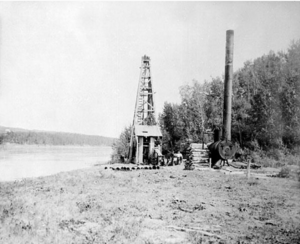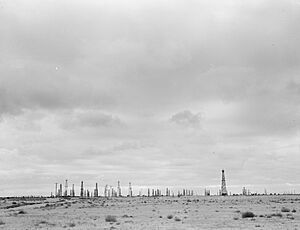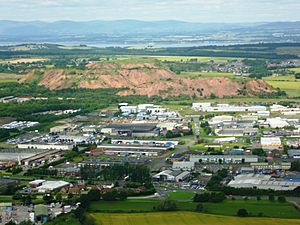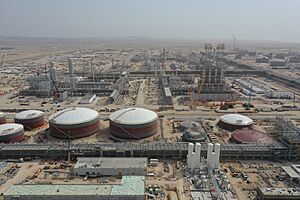History of the petroleum industry facts for kids
Oil has been used by people for thousands of years. But the modern way we get and use oil is quite new. Oil became super important in the late 1800s, especially because of coal and kerosene.
One big step was when people learned to make kerosene from crude oil. A scientist named Abraham Pineo Gesner found a way to make a liquid fuel from coal and oil shale. He called it kerosene. It burned much cleaner and was cheaper than whale oil, which people used for lamps back then.
Around the same time, in 1847, James Young noticed oil leaking from the ground. He found he could make a thin oil for lamps and a thicker oil for machines from it. The very first oil refineries and modern oil wells started in the mid-1800s. The United States and the Russian Empire (especially the area now called Azerbaijan) were the biggest oil producers then. They made 97% of the world's oil in the 1800s!
Oil became even more important in the early 1900s. This was because of the internal combustion engine used in cars and trucks. When diesel fuel started powering warships instead of steam, controlling oil became a key part of military plans. It played a big role in World War II. After the 1950s, oil took over from coal as the main fuel. It became super important for economies and caused some big energy crises.
Today, people worry about oil running out. This has led to new ways of getting oil, like fracking. It also makes us think more about cleaner energy. In the 1900s, air pollution from oil led to new rules. Now, in the 21st century, people are concerned about global warming from oil and gas. This makes the oil industry a hot topic in politics.
Contents
Oil's Early History
People have used oil for a very long time. More than 4,000 years ago, natural tar (called asphalt) was used to build the walls of Babylon. This tar was found near the Euphrates River. The ancient Greeks also knew about oil springs.
In China, people used oil over 2,000 years ago. Early Chinese writings mention using raw oil in the first century BC. The Chinese were also the first to use oil as fuel around 400 BC.
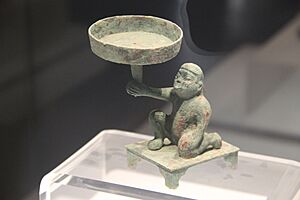
The earliest known gas wells were drilled in China around AD 347. They were about 800 feet deep. Workers used drilling tools attached to bamboo poles. The gas was burned to make salt. By the 900s, bamboo pipes connected gas wells to salt springs. In Japan, oil was called burning water in the 600s. A Chinese scientist named Shen Kuo created the word "rock oil" (Shíyóu) for petroleum in 1088. This is still the word used today in Chinese and Japanese.
The first streets of Baghdad were paved with tar from nearby oil fields. In the 800s, oil fields were used in modern Baku, Azerbaijan. A traveler named Marco Polo described these fields in the 1200s, saying they produced huge amounts of oil. By the 1100s, the process of distillation (separating liquids) reached Western Europe through Islamic Spain. Oil was also known in Romania from the 1200s.
The word "Petroleum" comes from monasteries in southern Italy. It was used there by the end of the first thousand years. Before that, people used words like "Naphta" or "Bitumen."
The first mention of oil in the Americas was in 1595 by Sir Walter Raleigh. He wrote about the Trinidad Pitch Lake. Later, in 1753, a map by Peter Kalm showed oil springs in Pennsylvania.
In 1745, the first oil well and refinery were built in Ukhta, Russia. A man named Fiodor Priadunov distilled "rock oil" to get a substance like kerosene. This was used in lamps for churches.
Oil sands were mined in France from 1745. The Pechelbronn oil field was active until 1970. It was where companies like Antar and Schlumberger started. The first modern refinery there was built in 1857.
Modern Oil History
Making Kerosene from Oil
The modern oil story really began in the 1800s. This is when people learned to make kerosene from crude oil. In 1847, Scottish chemist James Young saw oil leaking from a coal mine. He made a thin oil for lamps and a thicker oil for machines from it.
When the oil from the mine ran out, Young wondered if he could make it artificially. He found that by heating coal slowly, he could get a liquid like petroleum. He called one of his products "paraffine oil."
In 1850, Young and his partners opened the first truly commercial oil works and refinery in the world. It was in Scotland. They used oil from local rocks to make fuels and lubricating oils.
Kerosene for Lamps
Abraham Pineo Gesner, a Canadian geologist, found a way to make liquid fuel from coal and oil shale. He named his new discovery kerosene. It burned cleaner and was cheaper than whale oil. In 1850, Gesner started the Kerosene Gaslight Company. He began installing street lights in cities like Halifax. By 1854, he expanded to the United States.
Demand for kerosene grew. But it was hard for his company to make enough. Then, people discovered petroleum, which made it much easier to produce kerosene.
In 1852, Ignacy Łukasiewicz improved Gesner's method. He found a way to refine kerosene from "rock oil" that seeped from the ground. The first rock oil mine was built in Poland in 1854. These discoveries quickly spread. The first modern Russian refinery was built in Baku in 1861. At that time, Baku produced about 90% of the world's oil.
First Oil Wells
It's not totally clear which was the "first" commercial oil well. Many places had early oil activity. Edwin Drake's well in Pennsylvania in 1859 is often called the first modern well. This is because it was drilled with a steam engine. It also started a huge oil boom.
However, there was drilling before Drake. In 1846, a well was drilled in Azerbaijan using human and animal power. There were also engine-drilled wells in West Virginia in 1859. An early commercial well was hand-dug in Poland in 1853. Another was in Romania in 1857.
Oil Refineries
Oil distillation started in small refineries in the mid-1700s. These were in places like Russia and Poland. In the early 1800s, more small refineries opened. The first larger oil refineries opened in Poland and Romania. The Rafov Refinery in Romania, built in 1856, was called "the world's first systematic oil distillery."
This refinery supplied oil for lamps in Bucharest, Romania's capital. On April 1, 1857, Bucharest became the first city in the world lit entirely with distilled crude oil. In 1857, Romania produced 275 tons of crude oil. This made Romania the first country to be listed in world oil production statistics. This was before the United States (1860) or Russia (1863).
Oil in the United States
In 1875, oil was found by David Beaty in Pennsylvania. This led to the Bradford oil field. By the 1880s, this field produced 77 percent of the world's oil. But by the end of the 1800s, the Russian Empire took the lead in oil production.
Samuel Kier opened America's first oil refinery in Pittsburgh in 1853. Another important early oil well in North America was in Oil Springs, Ontario, Canada, in 1858. This discovery started an oil boom. Hundreds of people came to the area.
The modern U.S. oil industry is often said to have begun with Edwin Drake's oil well in 1859. It was 69 feet deep and near Titusville, Pennsylvania. This well first produced about 25 barrels of oil a day. The industry grew because of the demand for kerosene and oil lamps. In the early 1900s, the internal combustion engine created a huge demand for oil. This demand has kept the industry going ever since.
Oil in the 20th Century
By 1910, big oil fields were found in many places. These included Indonesia (1885), Persia (now Iran, 1908), Peru (1863), Venezuela (1914), and Mexico. They were all developed for industrial use.
Oil became super important for military power before and after World War I. Navies switched from coal to oil. Motor transport, tanks, and airplanes also needed oil. This thinking continued into World War II. During that war, oil facilities were major targets for bombing. In 1938, huge oil reserves were found in Saudi Arabia.
Until the mid-1950s, coal was the world's main fuel. But then oil quickly took over. After the 1973 and 1979 energy crises, people worried a lot about oil supplies. They realized oil is a limited resource that might run out. Even though some predictions were scary, oil production increased and demand went down in the 1980s. This caused an oil glut. But by the early 2000s, worries about peak oil returned.
Today, about 90% of the fuel for vehicles comes from oil. Oil also makes up 40% of all energy used in the United States. But it only creates 2% of electricity. Oil is valuable because it's a powerful energy source that powers most vehicles. It's also used to make many industrial chemicals. This makes it one of the world's most important products.
In the 2010s, a method called hydraulic fracturing (fracking) started being used a lot. It helps get oil and gas from shale rock in the United States, Canada, and China.
In 2006, the top three oil-producing countries were Saudi Arabia, Russia, and the United States. But in 2021, the United States produced much more oil than both Russia and Saudi Arabia. About 80% of the world's easily reached oil is in the Middle East. However, with high oil prices, Venezuela has even larger reserves because of its thick oil (bitumen).
See also
 In Spanish: Historia de la industria del petróleo para niños
In Spanish: Historia de la industria del petróleo para niños
Images for kids
-
An ancient Chinese bronze oil lamp from the Han dynasty.


